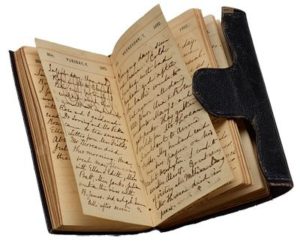 How do historians learn what really happened in the past? There are many ways to learn this information, but the most valuable way is through the study of primary sources. A primary source is an original piece of information created at the time under study such as a diary, letter, newspaper article including eye witness accounts, or public record, artwork, photograph or literature. Even archaeological artifacts are primary sources!
How do historians learn what really happened in the past? There are many ways to learn this information, but the most valuable way is through the study of primary sources. A primary source is an original piece of information created at the time under study such as a diary, letter, newspaper article including eye witness accounts, or public record, artwork, photograph or literature. Even archaeological artifacts are primary sources!
Secondary sources can also be helpful. They often include primary source information with additional comments or analysis. An example of a secondary source would be a magazine or newspaper article written to honor an anniversary of an event.
When doing historic research it is important to include primary sources so that you have examined direct links to the past. We are living through an historic time right now! How will future historians learn what life in quarantine during the COVID-19 pandemic was like? There will be the newspaper articles (in print and online) and recordings of the news broadcasts and hospital records, but how will they know what day-to-day life during the “stay at home” order was like? You can tell them!
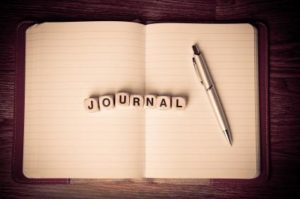 Journals are personal accounts of history. Do you keep one? Do you post on any social media? Then you are creating a primary source for future historians!
Journals are personal accounts of history. Do you keep one? Do you post on any social media? Then you are creating a primary source for future historians!
Print out this journal cover and put 4 or 5 additional pieces of blank paper on top, then fold in half to make a booklet. Put 2 or 3 staples very close to the fold to hold it all together.
Try keeping a daily record of your activities, thoughts and feelings for a whole week! Be sure to put the date at the top of each entry. Write down not only the basic information about what you did but also how you were feeling. What made you laugh today? Did you see something that made you sad when you saw a news segment on TV? Did your family eat a special meal together? How have your activities changed since before self-quarantine? Did you use Facetime or Zoom to keep in touch with friends or family members you are not able to see in person? Did you celebrate any special occasions like a birthday or graduation? How did you celebrate in a creative or unusual way? See if you can get other family members to keep a journal for the week, too. At the end of the week compare your entries — do you each have a unique perspective on the same activities?
Learn more!
Read an article with journal entries and photographs from the 1918 influenza epidemic https://www.smithsonianmag.com/history/what-we-can-learn-1918-influenza-diaries-180974614
Explore primary sources – what do YOU want to learn about? https://www.edutopia.org/blog/online-resources-primary-source-documents-monica-burns
Make history! Submit your story: https://medium.com/history-made-by-us/you-are-the-primary-source-211c33053bcf

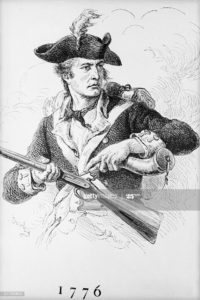
Soldier of 1776 filling his gun from powder horn. Undated engraving.
The Revolutionary War was fought on both sides of the battle lines by armies equipped with smooth bore, muzzle loading flintlock muskets. Cartridges rolled out of paper and filled with a musket ball and black powder were individually loaded and down the muzzle of the musket, packed at the breach with a ram-rod and fired by igniting a small amount of black powder in the priming pan. A good soldier could load and fire his weapon three or four times per minute.
None of this worked very well if the black powder got wet, so it was important to keep your powder dry! Prepared cartridges were carried in a leather cartridge box and loose black powder was often carried in a hollow horn of an ox or cow, fitted with a cover and a strap to carry it.
George Washington’s Continental Army had a lot of trouble getting enough black powder to keep the soldiers and artillery properly supplied. Almost all the black powder used during the American Revolution had to be imported from France or the French West Indies. One of the only working black powder mills in America was the Frankford Powder Mill, in what is now part of Philadelphia!
Black powder is a mixture of three ingredients. This means that each ingredient remains distinct within the formula. They were ground together in mills, much like a grain mill. Powder mills were powered by wind or water and located away from heavily populated areas because of the risk of accidental explosion.
You can keep your powder dry in a powder horn that you create out of simple materials you probably have at home!
You will need: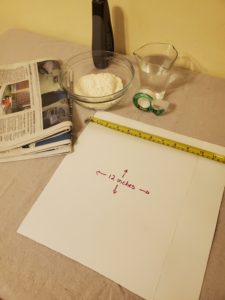
- 12-inch square of poster board or similar material – I used an old gift box that I cut to size!
- Tape
- Scissors
- 6 pages of newspaper
- ½ cup of flour
- 1 cup water
- Bowl
- Whisk
- Craft paint and paintbrush
- Marker
- 36 to 48 inches of string, yarn or ribbon
This is a fun but messy project, so cover your work surface with an old tablecloth, extra newspaper or a garbage bag.
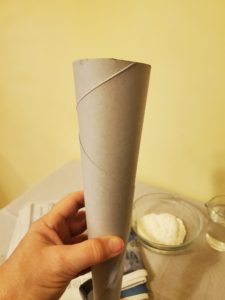 Roll the poster board into a cone shape and tape it to hold together – a staple at the wide end is helpful. Trim the wide end so that it is flat and even.
Roll the poster board into a cone shape and tape it to hold together – a staple at the wide end is helpful. Trim the wide end so that it is flat and even.
Tear the newspaper into strips about 2 inches wide.
Mix the flour and water in the bowl.
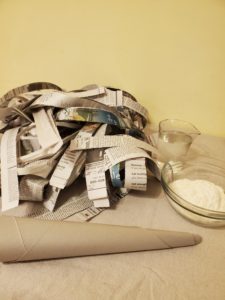 Wet several strips of newspaper at a time in the flour mixture. Take one strip at a time out, wipe off the excess liquid and apply it to the cone. As you build layers, try and smooth them out. Add strips to the narrow end and twist them up to make the curved point.
Wet several strips of newspaper at a time in the flour mixture. Take one strip at a time out, wipe off the excess liquid and apply it to the cone. As you build layers, try and smooth them out. Add strips to the narrow end and twist them up to make the curved point.
When you are pleased with the shape, set it aside on a plastic bag to dry overnight. Don’t forget to clean up your mess!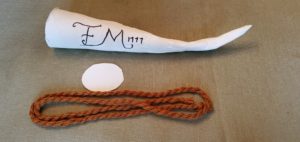
The next day, trace the open end on a scrap of poster board and cut this out to make the lid.
Paint everything! Horns were naturally an off-white to light tan color but you can decide what color you want based on what color paint you have at home. When the paint is dry you can decorate it with the marker.
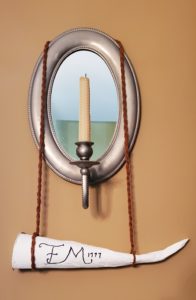 Soldiers often carved things in their powder horns during long winter days in camp. They might carve their initials or name, battles they fought in, or popular expressions. How will you decorate yours?
Soldiers often carved things in their powder horns during long winter days in camp. They might carve their initials or name, battles they fought in, or popular expressions. How will you decorate yours?
Attach the lid with a piece of tape or string attached through a hole in the top of the horn. Then attach your carrying string and you are ready to join General Washington!
Learn more!
Read about the gunpowder supply in the American Revolution
Discover the powder horn that belonged to an African American patriot.
And watch this video from the American Battlefield Trust.
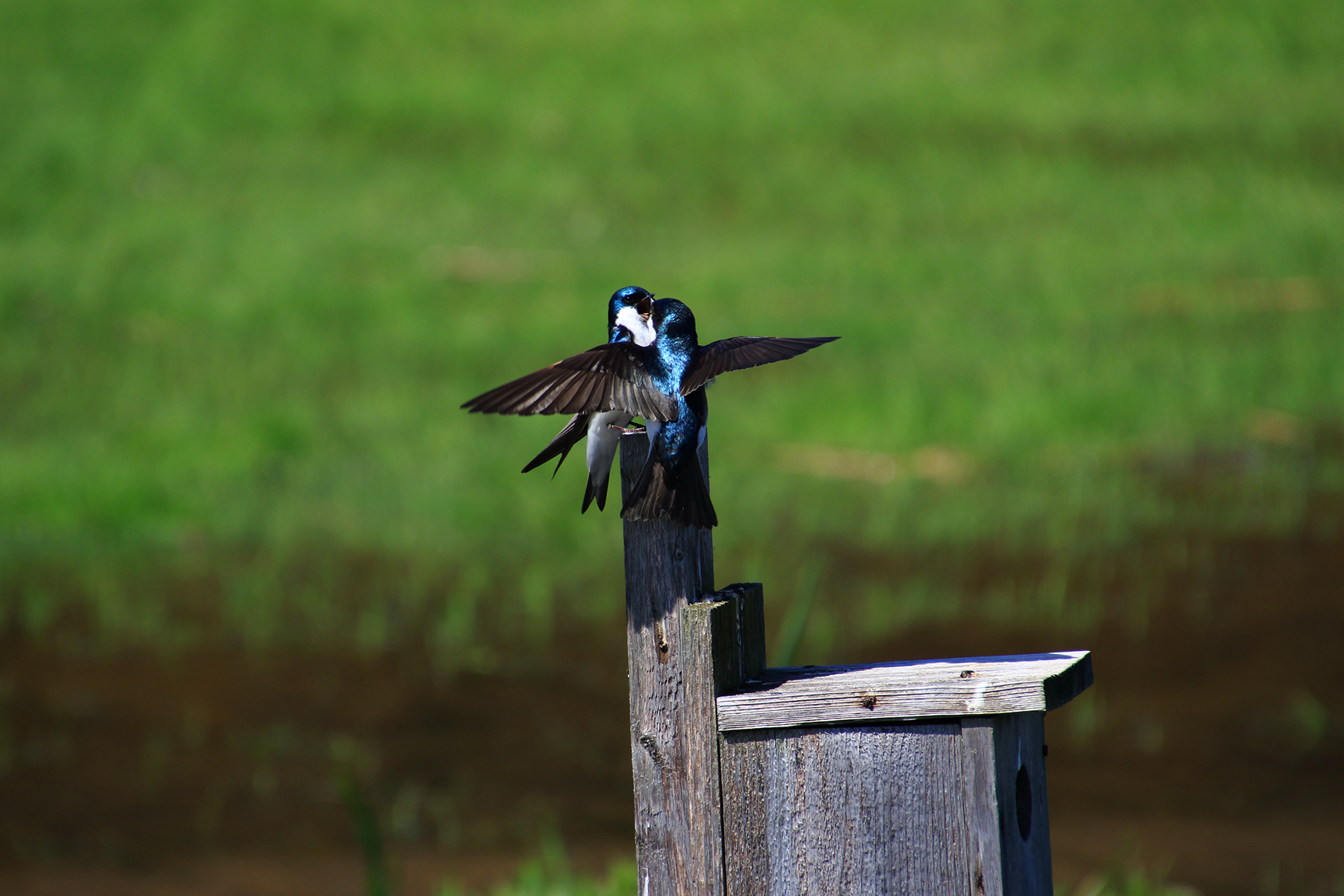
Fort Mifflin’s location on Mud Island makes it an ideal location for insect populations, including pesky mosquitoes. For today’s #MakeItBetterMonday, discover a couple of things you can make to combat the insect population on your next visit to the Fort or in your own back yard.
Click HERE for information, project instructions and interesting links for learning more!
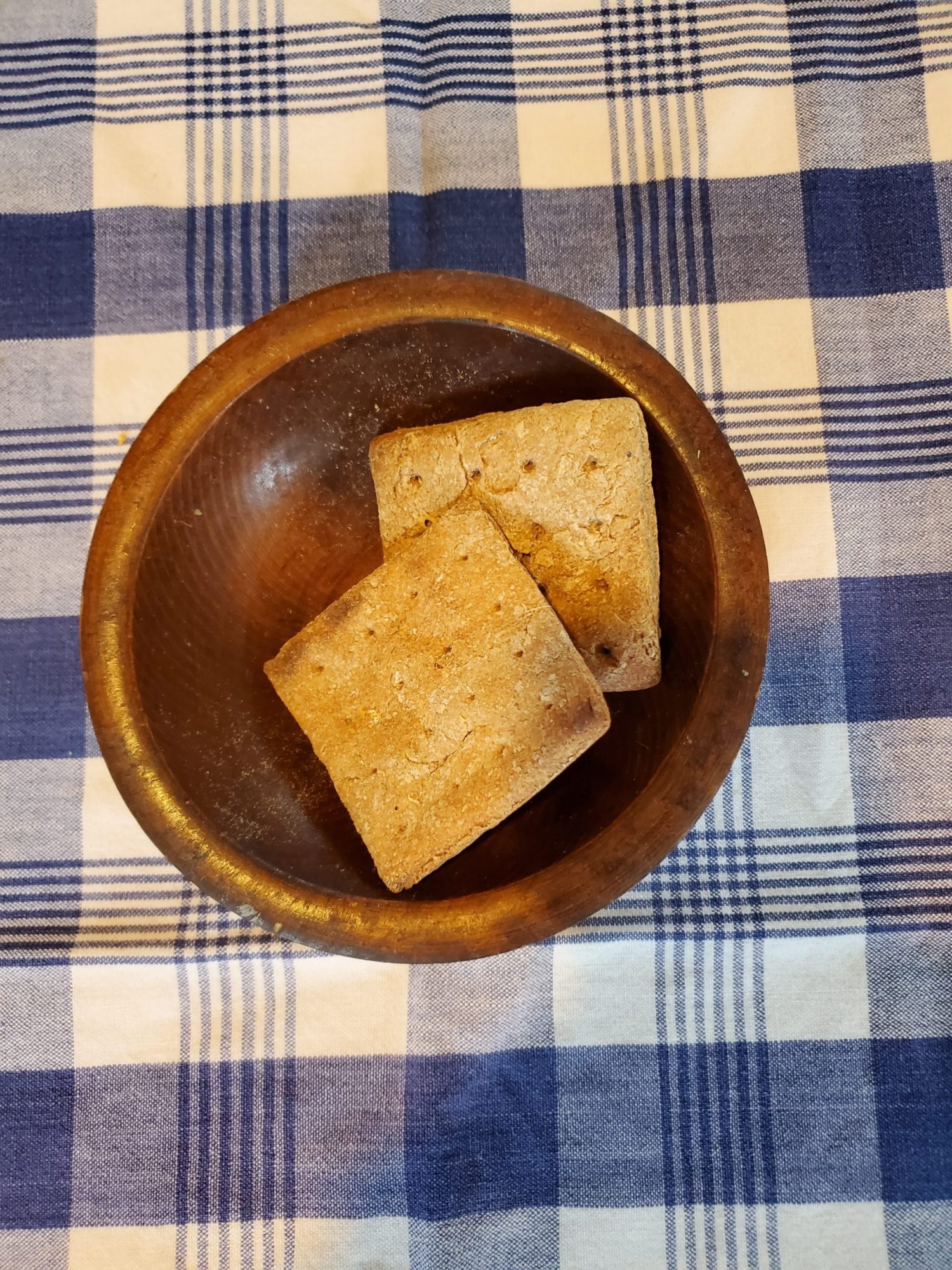
Does an army really march on its stomach? What did soldiers during the American Revolution actually eat? Explore the basics of 18th century military mess and then mix up a batch of hard tack and try it for yourself! #MakeItBetterMonday
Click HERE for information and links, plus the recipe to try at home!
 How do historians learn what really happened in the past? There are many ways to learn this information, but the most valuable way is through the study of primary sources. A primary source is an original piece of information created at the time under study such as a diary, letter, newspaper article including eye witness accounts, or public record, artwork, photograph or literature. Even archaeological artifacts are primary sources!
How do historians learn what really happened in the past? There are many ways to learn this information, but the most valuable way is through the study of primary sources. A primary source is an original piece of information created at the time under study such as a diary, letter, newspaper article including eye witness accounts, or public record, artwork, photograph or literature. Even archaeological artifacts are primary sources! Journals are personal accounts of history. Do you keep one? Do you post on any social media? Then you are creating a primary source for future historians!
Journals are personal accounts of history. Do you keep one? Do you post on any social media? Then you are creating a primary source for future historians!






